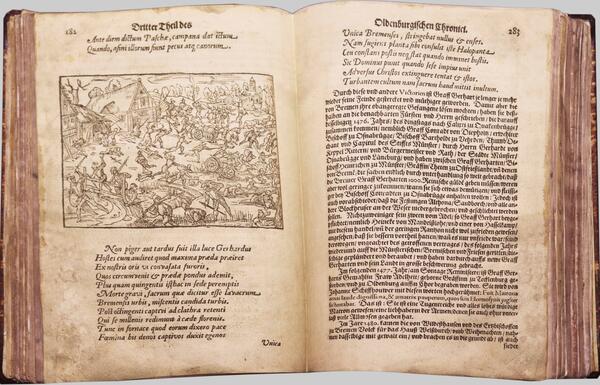Book ‘The Oldenburg Chronicon’ is devoted to the history of the old Mecklenburg noble family. German theologian Hermann Hamelmann finished it by 1593, but the book was not published until after his death, in 1599 — due to the political ambitions of Johann VII, Count of Oldenburg. Some historical facts were ‘corrected’ in the right context by court lawyer Albert Goering. Data about 1593-1599 was later added to the Chronicle by Count Neuwalt’s physician in charge. The original text of the Chronicle was published only in 1940 under the editorship of German philologist G. Ruethning.
The book is published in the in folio format. It contains 293 sheets of text, 4 attachments, 3 blank sheets for owners' notes. The book is written in two languages — Old German and Latin. The text is illustrated with 63 engravings depicting Oldenburg, its rulers and their spouses, the author of the book, as well as the coats of arms and seals of members of the Oldenburg family.
4 attachments are inserted into the page block: the genealogy table of Elimar I between pages 94 and 95; the genealogy table of Elimar II between pages 188 and 189; the plan of Oldenburg between pages 374 and 375; and the genealogy table of the Counts of Oldenburg between pages 480 and 481. There are proprietary handwritten inscriptions on the flyleaf and binding sheets, some of which are illegible. On sheet 26, a mark is preserved on the margins, which is written in Latin letters by hand, in black ink, in 7 lines. The owner’s blue stamps are preserved on the flyleaf: ‘F. BRADER Swieshenahn Grossh. Oldbg’.
Book ‘The Oldenburg Chronicon’ is devoted to the history of the old Mecklenburg noble family. German theologian Hermann Hamelmann finished it by 1593, but the book was not published until after his death, in 1599 — due to the political ambitions of Johann VII, Count of Oldenburg. Some historical facts were ‘corrected’ in the right context by court lawyer Albert Goering. Data about 1593-1599 was later added to the Chronicle by Count Neuwalt’s physician in charge. The original text of the Chronicle was published only in 1940 under the editorship of German philologist G. Ruethning.
The book is published in the in folio format. It contains 293 sheets of text, 4 attachments, 3 blank sheets for owners' notes. The book is written in two languages — Old German and Latin. The text is illustrated with 63 engravings depicting Oldenburg, its rulers and their spouses, the author of the book, as well as the coats of arms and seals of members of the Oldenburg family.
4 attachments are inserted into the page block: the genealogy table of Elimar I between pages 94 and 95; the genealogy table of Elimar II between pages 188 and 189; the plan of Oldenburg between pages 374 and 375; and the genealogy table of the Counts of Oldenburg between pages 480 and 481. There are proprietary handwritten inscriptions on the flyleaf and binding sheets, some of which are illegible. On sheet 26, a mark is preserved on the margins, which is written in Latin letters by hand, in black ink, in 7 lines. The owner’s blue stamps are preserved on the flyleaf: ‘F. BRADER Swieshenahn Grossh. Oldbg’.
For this book, the publisher chose a font that matches the Schwabacher type, a form of Gothic writing originated in the 15th century. The Oldenburg Chronicon is an object of cultural heritage, because there are only about 70 of them preserved. The Chronicon, which is exhibited in the Entourage Pavilion, has been preserved in the best condition, despite mechanical damage, abrasions of the leather elements of the cover, creases and tears of pages and the spine. Time also had a physical and chemical effect: paper delamination, foxings, stains, traces of moisture are noticeable.
For this book, the publisher chose a font that matches the Schwabacher type, a form of Gothic writing originated in the 15th century.
The Oldenburg Chronicon is an object of cultural heritage, because there are only about 70 of them preserved. The Chronicon, which is exhibited in the Entourage Pavilion, has been preserved in the best condition, despite mechanical damage, abrasions of the leather elements of the cover, creases and tears of pages and the spine. Time also had a physical and chemical effect: paper delamination, foxings, stains, traces of moisture are noticeable.



